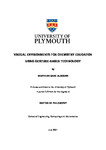VIRTUAL ENVIRONMENTS FOR CHEMISTRY EDUCATION USING GESTURE-BASED TECHNOLOGY
| dc.contributor.supervisor | Ghita, Bogdan | |
| dc.contributor.author | Aldosari, Shaykhah | |
| dc.contributor.other | School of Engineering, Computing and Mathematics | en_US |
| dc.date.accessioned | 2021-12-10T11:09:50Z | |
| dc.date.issued | 2021 | |
| dc.identifier | 10484907 | en_US |
| dc.identifier.uri | http://hdl.handle.net/10026.1/18454 | |
| dc.description.abstract |
Gesture-based technology has considerably improved in recent years. Such technology allows users to interact naturally with objects in a three-dimensional virtual space. The Leap Motion controller is one example of a device using gesture-based technology, and such devices have vast potential in education. This research focuses on identifying the effects of gesture-based technology on learning, specifically on chemistry education. The research hypothesis is that such technologies in the education field positively influence the general learning experience and improve student comprehension. A chemistry educational system using a gesture-based device and integrating the experiment simulations and the visualisation of molecules in secondary school is proposed and studied. This system provides intuitive methods of conducting chemistry experiments through gesture-based technology and presenting chemistry concepts via macroscopic and microscopic views. The effectiveness of the proposed system is evaluated through a rigorous analysis that includes a mix of quantitative and qualitative research methods. The experimental study results demonstrate that the proposed system improves student learning achievement compared to traditional learning methods. Thus, the proposed educational system results confirm the research hypothesis, indicating the importance of using gesture-based technology in education, as the system can positively influence learning by replacing traditional learning with technology-based learning. Therefore, this research focuses on a new methodology for e-learning, using new advancements in technology. The research also provides a comprehensive understanding of the effect of gesture-based technology, creating a solid foundation for further enhancements to e-learning. | en_US |
| dc.language.iso | en | |
| dc.publisher | University of Plymouth | |
| dc.subject | Gesture-based Technology | en_US |
| dc.subject | Leap Motion controller | en_US |
| dc.subject | Human-Computer Interaction | en_US |
| dc.subject | E-learning | en_US |
| dc.subject | Simulation | en_US |
| dc.subject | Virtual Lab | en_US |
| dc.subject.classification | PhD | en_US |
| dc.title | VIRTUAL ENVIRONMENTS FOR CHEMISTRY EDUCATION USING GESTURE-BASED TECHNOLOGY | en_US |
| dc.type | Thesis | |
| plymouth.version | publishable | en_US |
| dc.identifier.doi | http://dx.doi.org/10.24382/1209 | |
| dc.rights.embargodate | 2022-12-10T11:09:50Z | |
| dc.rights.embargoperiod | 12 months | en_US |
| dc.type.qualification | Doctorate | en_US |
| rioxxterms.version | NA | |
| plymouth.orcid_id | https://orcid.org/ 0000-0001-9516-9121 | en_US |
Files in this item
This item appears in the following Collection(s)
-
01 Research Theses Main Collection
Research Theses Main


